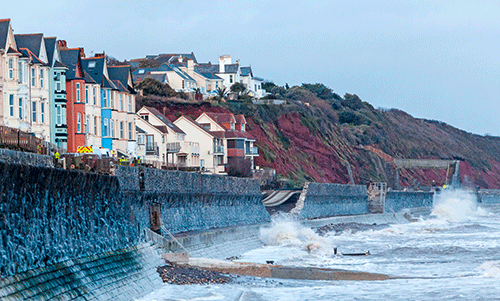 Read the peer review for this article
Read the peer review for this article
Britain’s weather is changing - that’s a fact. And the railway will have to change in response. The impact will be gradual, but the cost will be staggering.
The railway will have to withstand the effects of increasingly extreme weather associated with climate change projections. Warmer, drier summers and more intense periods of winter rainfall are anticipated.
Some aspects are already measurable. Near Southampton, the sea level has been rising by 1.5mm a year since data collection started in 1935. Annual rainfall and average temperature have both increased noticeably in the past 30 years.
On the railway, it can be detected in Network Rail’s increasing Schedule 8 payments to train operators for disruption. Over the past eight years the average annual cost attributed to weather was more than £50 million. Following a change to the rate of compensation payments, from now on it is expected to rise to £80m.
Performance cost, repair cost and wider economic cost all underline the need for enhanced spending to increase weather resilience.
“It is key that we take a long-term view,” says Rob Nicholls, Professor of Coastal Engineering at the University of Southampton. “Over the next ten to 20 years the risks to the railway will grow a little bit. But it is not going to be a dramatic change.”
Network Rail expects the railway between Folkestone and Dover to remain closed until December 2016, after winter storms cracked the protective sea wall and undermined the base of the railway last Christmas Eve.
Repairing it with a 235-metre concrete viaduct, supported on columns sunk into the beach and protected by 90,000 tonnes of rock, will cost £44.5m. That money was not planned for in Network Rail’s budget.
At Dawlish, Nicholls suggests that “raising the rail bed a little may be sufficient for our working lifetimes. Beyond that something more substantial will be needed.”
He adds: “In most cases we are going to want to stay put, upgrading the resilience of the railway to withstand bigger waves and higher tides. That should cover a 30- to 40-year timeframe. Further ahead the risks are very much larger.
“At the low end of predictions, sea level will rise at its present rate. That is 20cm to 30cm over the next 100 years. In the higher scenarios, a one-metre rise is clearly plausible. Two metres is unlikely, but not impossible. And clearly the cost difference in planning for different levels is very large. The trouble is, the long-term view is often lost in the immediate need to react to day-to-day situations.”
At Dawlish, a 2014 study by the University of Southampton found that by the end of this century the annual number of days with line restrictions will rise from today’s ten to between 84 and 120. This will include major disruptive events each year that could result in lengthy line closures.
A 2010 study similarly concluded that the sea level rise could cause rail services through Dawlish to be disrupted on average for 35% of the winter by 2060.
Inland, it is suggested that the April 2016 landslip at Wrecclesham (near Farnham) was influenced by climate change. A clay embankment on the line to Alton became saturated with water and slipped towards the river flood plain. Vegetation on the slope was unable to maintain stability as the pores in the clay filled up.
The line was closed for weeks. Buses replaced trains while a temporary fix using steel piles was prepared. A more permanent solution is expected to take months and cost millions of pounds.
“During routine maintenance we discovered a small landslip on April 6,” says Network Rail spokesman Ross Easton. “We monitored it over two days and imposed a speed restriction of 5mph. It then became quite severe. At its worst point it dropped by six feet.”
Some 250 metres of track were lifted, and steel piles were inserted where the track previously lay. The line was then slewed to the far side of the embankment, like a chicane. Rail services resumed in early May at low speed, pending further work.
The railway is aware of the challenges. The RSSB has a research plan called Tomorrow’s Railway and Climate Change Adaptation (TRACCA), led by consultant Arup. It has published reports over the past three years, and its final conclusions were published just before this issue of RailReview went to press (see page 62).
These reports state that it is not possible to link individual consequences of extreme weather explicitly to climate change. But the events form a pattern that is consistent with predictions of the effects of a changing climate.











